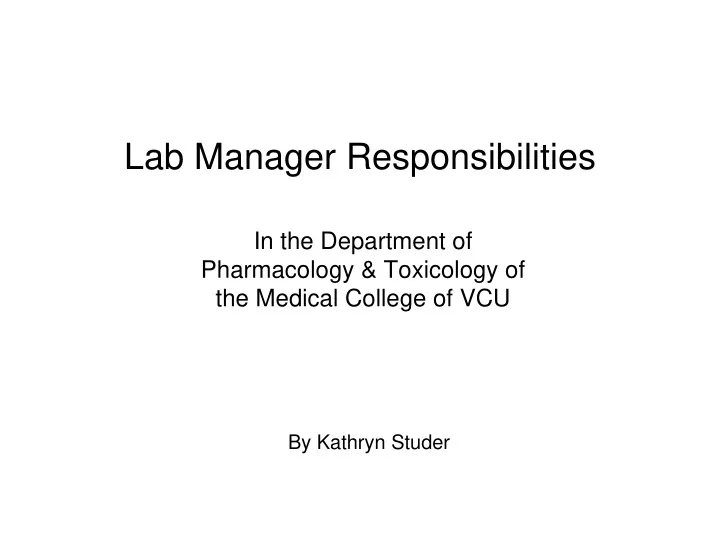

Lab Manager Responsibilities In the Department of Pharmacology & Toxicology of the Medical College of VCU By Kathryn Studer
Ordering Procedures • Purchase Orders – All orders under $5,000 – Order form is filled out (with grant code, address, quantity, and quotes, etc) – 1 copy is placed in our records, another is taken up stairs • RO1 NIH Federally Funded Grants 5-45075 5-45104 5-45022 5-41124 – All reagents or equipment is ordered under one of these grants.
Ordering Procedures Credit Card Order - This lab has 2 Corporate Credit Cards - Statements must be turned in every month, along with the invoice and packing slip for each charge Equipment Orders over $5,000 - A justification, and a financing quote must be approved by the business office before purchasing
Maintaining Lab Safety HAZARDOUS WASTE • Hazardous Waste Generator’s Name_________________________ Department & Phone #____________________ – Each Bottle/Drum is Bldg./Floor/Room#_______________________ labeled Date Filled___________ pH____________ – An appointment is then Chemical Name(s) Percent or Volume made with OEHS _________________ _______________ _________________ _______________ – All Hazardous Waste is _________________ _______________ _________________ _______________ disposed of in B2 of Sanger Hall Once container is full, contact the Chemical Safety Section for disposal at (804) 828-1392.
Maintaining Lab safety •Radiation Safety - Attending Radiation Safety Class to become certified - Ordering shipments of radioactivity - Keeping a detailed inventory - Properly disposing of solid and liquid waste Recent Activity
Lab Cleanliness Responsibilities Dr. Ningjun Li June Lily Jenny Mark Renal Vessel Biochemistry Molecular Functions Lab Lab Function Lab Lab � Micro-vessel � Fluorescence � Cell Culture � 3 Surgery Profusion System Microplate Reader Hood Operation Stations � 8 Channel DMT � Spectrophotomet � Tetemetry System � Liquid N2 Tank System er � Water bath � Metabolic Cages � Patch Clamp � HPLC � Incubators � IVIS System Setup � ESR � Ultrasonic Cell � In Vivo Imaging � ELISA � Flowcytometer Disruptor System � 2 Micro- � Refrig/Freezer � iCycler � Servo Control dissection System � D water system � Refrig/Freezer systems � Micro-dissection (Nano Pure) � Fluorescence Microscope
Lab Instruments • All Instruments have a file in the main office • If an instrument breaks down: – Tech Support or Ed Dimen must be called immediately Last month : • Our centrifuge & our distill was not working • Tech support fixed our Centrifuge • Ed Dimen could not repair our distill • We ordered a deionizer which Ed intalled
Genotyping ASM Mice Protocol Rationale Genotyping determines whether a mouse is homozygous for wild type (WT) or knockout (KO), or whether a mouse is heterozygous for both the WT and the KO genes. Reagents Platinum PCR SuperMix: Invitrogen cat. #: 11306-016 Primers: Ps 5’-AGC CTG GTC CTC TTC CTT AC-3’ PA1 5’ –CGA GAC TGT TGC CAG ACA TC-3’ PA2 5’ –GGC TAC CCG TGA TAT TGC TG-3’ 0.5ul of template mouse DNA* for each sample (0.25ug) (3 mice with 2 DNA samples each) 100bp DNA ladder
Genotyping ASM Mice Protocol Solutions 40ml 1X TAE Buffer (extra buffer is needed) and 0.6g of Agarose heated in the microwave until dissolved. (11/2min, mix every 20sec. Do Not Boil Over) 10ul Ethidium Bromide dye Protocol 1. Add 22.5ul of PCR SuperMix, 0.5ul of the Ps primer, and 0.5ul of template mouse DNA to 6 thin-walled 0.5ml tubes. 2. Add 0.5ul of A1 primer to the first set of tubes for the 3 mice to test for the WT gene. Vortex briefly. 3. Add 0.5ul of A2 primer to the second set of tubes for the 3mice to test for the ASM KO gene. Vortex briefly. 4. Centrifuge all tubes for 6 sec. 5. Place tubes in PCR machine on the “ASM Tail 2” setting to amplify the DNA segments.
Genotyping ASM Mice Protocol The gel electrophoresis • Heat 40ml of 1X TAE buffer and 0.6g of Agarose until it dissolves. • Pour solution into gel holder. Add comb to make wells. • When the PCR is done, put 10ul from each tube into new tubes with 2ul of 6x dye. • Remove the barriers and comb from the gel after it has set and cover the gel with 1X TAE buffer. • Add 12ul of the sample to each separate well on the gel. • Add the 100bp DNA ladder to the middle well. • Run the gel at 70volts for about 50min. 13. Afterwards Cover the gel with 1X TAE Buffer and add 10ul of Ethidium Bromide. 14. Shake gently for 10min then pour off the solution into appropriate container. 15.Take a picture of the gel results Reading the gel 16. In ASM mice the KO gene has 523bp, and the WT gene has 269bp
ASM Mouse Genotyping Results 1 2 3 4 5 6 523bp 269bp WT gene KO gene
New Fellows Computer Lab Coat & NIH Notebook VCU Card/VCU Email/Building Access Register at the Office of International Education Social Security Number Bank Account
Recommend
More recommend